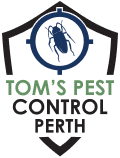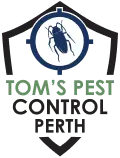Prompt, Affordable Same-Day Pest Control in Perth – From $129.
- Home
- Pest Treatments
- Termite Inspection & Treatment
- Ant Pest Control
- Bed Bug Treatment
- Beetle Pest Control
- Bird Control
- Borer Pest Control
- Cockroach Control
- Flea Control
- Fly Control
- Fox Trapping
- Mite Control
- Mosquito Pest Control
- Moth Control
- Possum Removal
- Silverfish Control
- Spider Control
- Wasp Control
- Rats And Mice Control
- End of Lease Pest Control
- Pest Management Perth
- General Pest Control
- Commercial Pest Control
- Office Pest Control
- Restaurants & Cafes Pest Control
- Hospitality Pest Control
- Education Facilities Pest Control
- Hospital & Aged Care Pest Control
- Pest Control Food Industry
- Factories & Warehouses Pest Control
- Government Buildings Pest Control
- Assets & Facilities Pest Management
- Farming and Agriculture Pest Control
- Strata Pest Control
- Construction Pest Control
- General Pest Control
- Termites
- Pest Info
- Pest Inspection
- Contact
- Home
- Pest Treatments
- Termite Inspection & Treatment
- Ant Pest Control
- Bed Bug Treatment
- Beetle Pest Control
- Bird Control
- Borer Pest Control
- Cockroach Control
- Flea Control
- Fly Control
- Fox Trapping
- Mite Control
- Mosquito Pest Control
- Moth Control
- Possum Removal
- Silverfish Control
- Spider Control
- Wasp Control
- Rats And Mice Control
- End of Lease Pest Control
- Pest Management Perth
- General Pest Control
- Commercial Pest Control
- Office Pest Control
- Restaurants & Cafes Pest Control
- Hospitality Pest Control
- Education Facilities Pest Control
- Hospital & Aged Care Pest Control
- Pest Control Food Industry
- Factories & Warehouses Pest Control
- Government Buildings Pest Control
- Assets & Facilities Pest Management
- Farming and Agriculture Pest Control
- Strata Pest Control
- Construction Pest Control
- General Pest Control
- Termites
- Pest Info
- Pest Inspection
- Contact
Bull Ants
(08) 6202 7096
Get A Free Quote Now!
Get A Free Quote Now!
Bull Ants
Bull ants have an impressive size and distinct behaviour that sets them apart from other ant species. They’re known for their highly aggressive nature and may sting humans when threatened. With excellent eyesight, they can hunt prey up to one meter away. Similar to other ant species, bull ants build their colonies underground, making ant control essential to prevent infestations and ensure safety.
Bull ants can reach an impressive size of up to 40 mm and are easily recognisable due to their large eyes and long, slender mandibles. With exceptional vision, they can track and chase their prey from a distance of up to three feet.
Australia is home to approximately 90 species of bull ants. Many of these species have brightly coloured heads or red and orange abdomens. Some smaller species of bull ants are known as jumper ants, as they’re prone to aggressively leaping onto intruders.
Bull ants are found in various habitats throughout Australia, including urban areas, forests, and heathlands. They build their nests outdoors, below soil, rocks, and logs. However, they can also be found in coastal regions, sand plains, and desert areas.
Bull ants have a varied diet, which includes nectar and other plant liquids, fruits, seeds, and insects. They can often be found near food sources, as they prefer to forage and bring their finds back to their nests.
The life cycle of bull ants comprises four stages: eggs, larvae, pupae, and adulthood. It takes several months for an ant egg to develop into an adult. After mating, the bull ant queen digs a hole in her nest to lay her eggs safely.
Bull ants can construct two types of nests: simple and complex. A noticeable central shaft characterises the simple nests in the middle of the mound. On the other hand, the complex nests are built underground and are surrounded by mounds.
In certain bull ant species, there are no worker ants present. In these cases, the invading queen enters the nest of another species, kills the current queen, and takes over the colony.
Danger to Humans
Bull ants are aggressive and may sting humans if provoked. Their sting can be painful but can be managed with an ice pack. However, if you experience any allergic reaction, you must seek medical help immediately.
Trust The Bull Ant Removal Experts
Due to their size, aggressiveness, and potent sting, bull ants can be dangerous if encountered. Thus, hiring Pest Control Perth professionals to eradicate these creatures from your property is imperative.
Tom’s Pest Control is the perfect solution if you want to eliminate pests from your property. We employ various methods, including traps, baits, and other effective techniques, to eliminate bull ants completely. Furthermore, our pest control professionals have the knowledge and expertise to handle any pest situation, regardless of size.
Tom’s Pest Control recognises the potential threat that bull ants pose to your home or business. As a result, we utilise the latest and safest pest control techniques to eradicate these pests. Our skilled pest control professionals work rapidly and efficiently to eliminate bull ants while taking preventative measures to discourage their return.
Call Us
Take immediate action to address your pest issues. Contact Tom’s Pest Control now for trustworthy, secure, and efficient bull ant eradication services.
Frequently Asked Questions
Do Bull Ants Attack Humans?
The aggressive behaviour of bull ants makes them prone to attacking humans when they feel endangered. They cling to their target using their powerful mandibles and then administer a sting. Unfortunately, their bite can be painful and trigger allergic reactions.
Where Can You Find Bull Ants?
The natural habitat of bull ants is primarily in Australia, where they reside in forests and woodland regions. Additionally, they can be found in multiple urban areas. These ants tend to gather and live in regions abundant in food sources.
Where Do Bull Ants Build Their Nests?
Bull ants construct their nests several meters beneath the ground, making it uncommon for humans to spot them. The openings to these nests are often small and challenging to identify. Bull ants are not hesitant to attack intruders who come too close to their nests, regardless of their size.
 (08) 6202 7096
(08) 6202 7096


